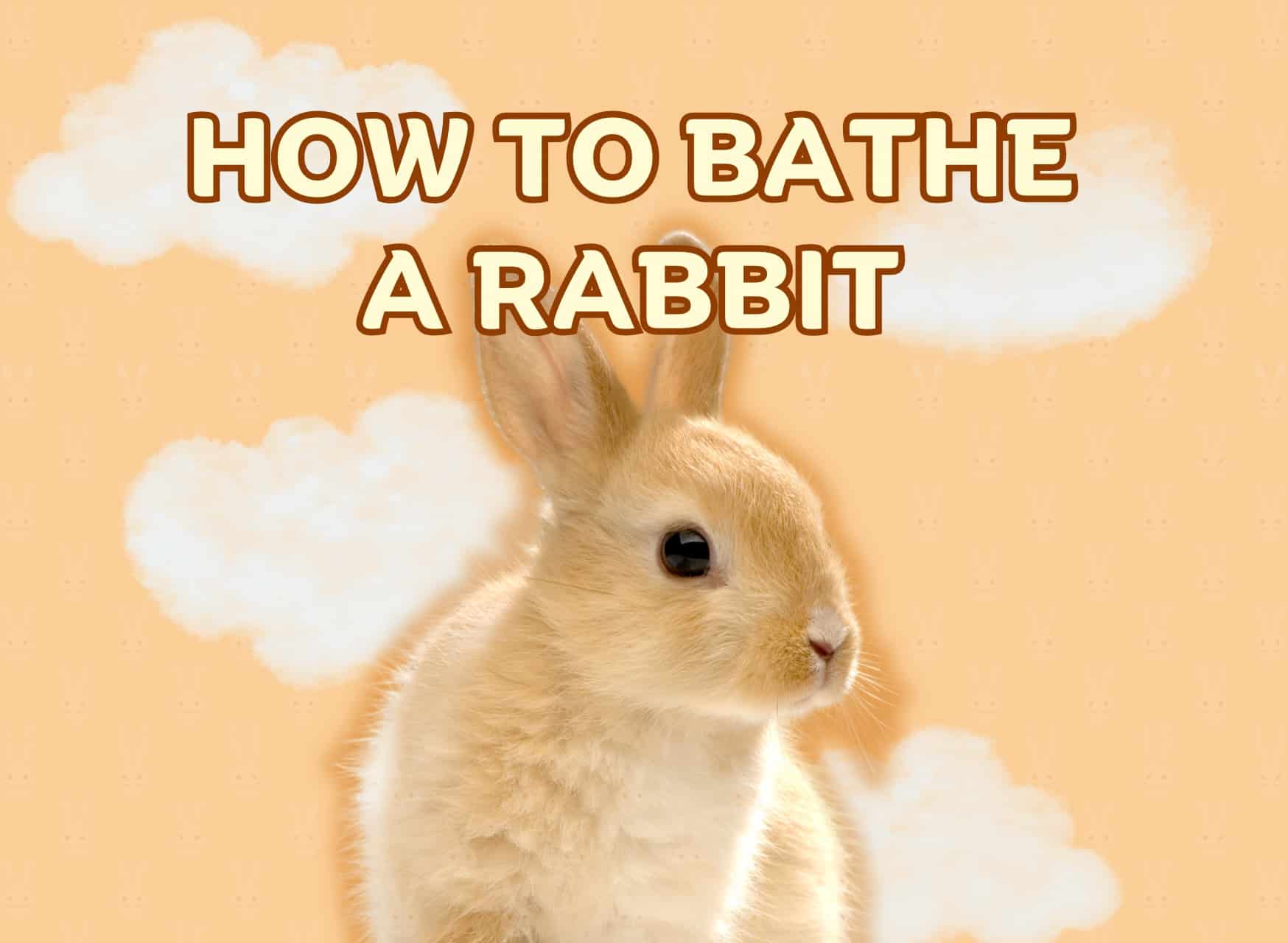Crack the Code: 20 Mysterious Common Cat Behaviors and What They Really Mean
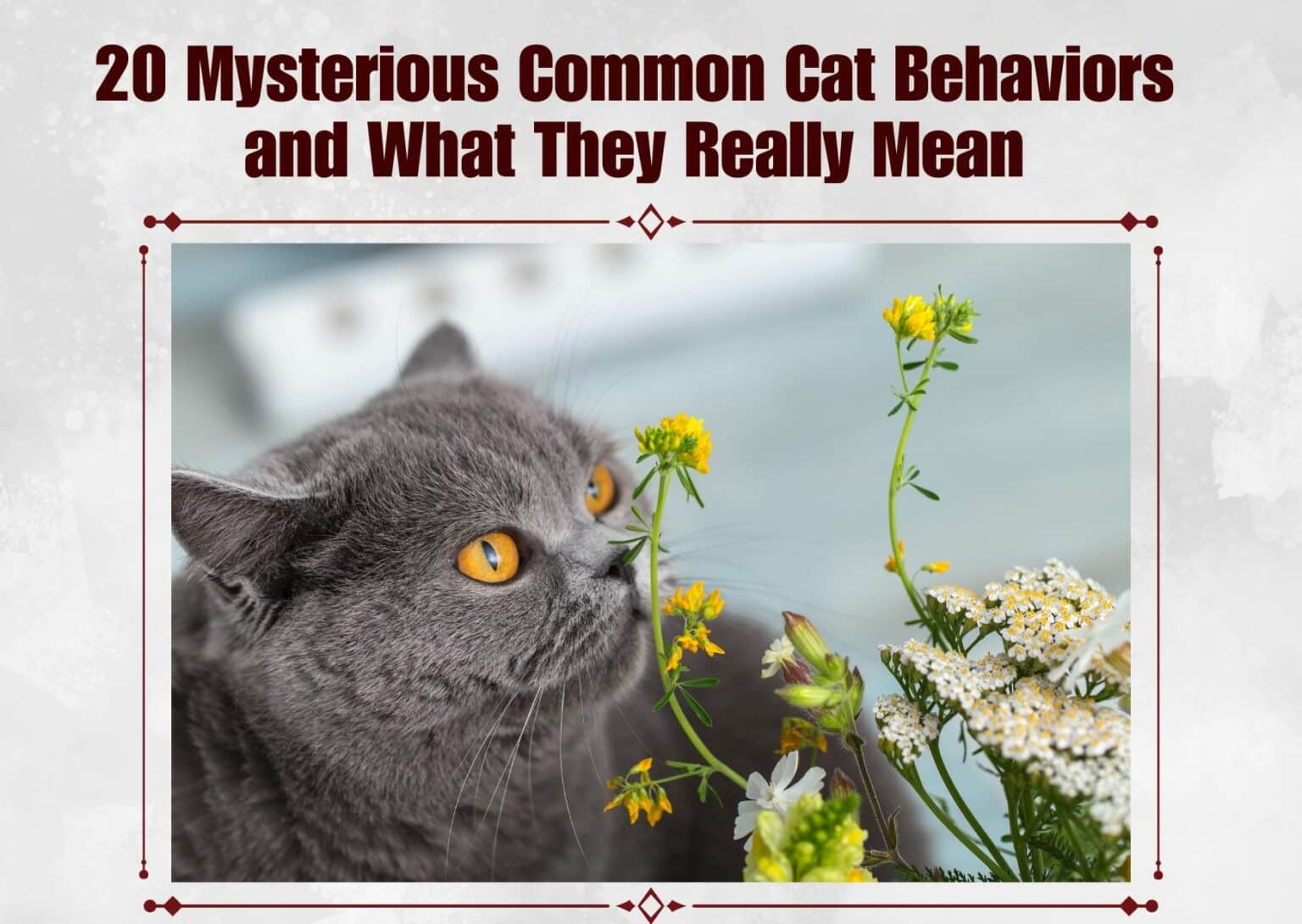
Sharing is Caring!
Introduction
Welcome to the intriguing world of cats! These mysterious creatures have been captivating humans for centuries with their enigmatic behaviors. But fear not, dear cat owners, for we are here to decode their peculiar actions and shed light on what they really mean. From the gentle headbutt to the relentless kneading, cats communicate through a unique language of their own. Have you ever wondered why your feline friend brings you “gifts” of dead mice or birds? Or why they suddenly zoom around the house at lightning speed, only to abruptly stop and stare at nothing? We will unravel the secrets behind these seemingly bizarre behaviors.
In this comprehensive guide, we will delve into the various ways cats interact with their environment and humans. You will discover the deeper meanings behind their purring, meowing, tail flicking, and litter box antics. Understanding your cat’s behavior can strengthen the bond between you and your four-legged companion, ultimately leading to a happier and healthier relationship. So, join us on this journey as we decode 20 common cat behaviors and unlock the mysteries of your feline friend’s world. Get ready to gain insight into the wondrous and purr-fectly normal behaviors of our beloved feline friends.
Communication Behaviors

Body Language
Cats are masters of nonverbal communication, and cat’s body language speaks volumes. The position of their tail can reveal a world of emotions: an upright tail signifies confidence, while a puffed-up tail signals fear or agitation. Keep an eye on their ears too – forward-facing ears denote curiosity, while flattened ears indicate irritation or fear. And who can resist the soothing rumble of a contented cat’s purr? It’s their way of saying they’re happy and at ease, a universal language of comfort.
Vocalizations
When it comes to vocalizations, cats have a symphony of sounds that can leave us both puzzled and delighted. The meow, often directed at humans, has an array of variations – from the demanding “feed me” meow to the affectionate greeting meow. On the other end of the spectrum, hissing and growling are signs of a frightened or defensive cat, while chirping and trilling are reserved for moments of sheer excitement or friendly acknowledgment. These weird noises are their way of communicating emotions that words alone could never capture.
Play and Hunting Behaviors
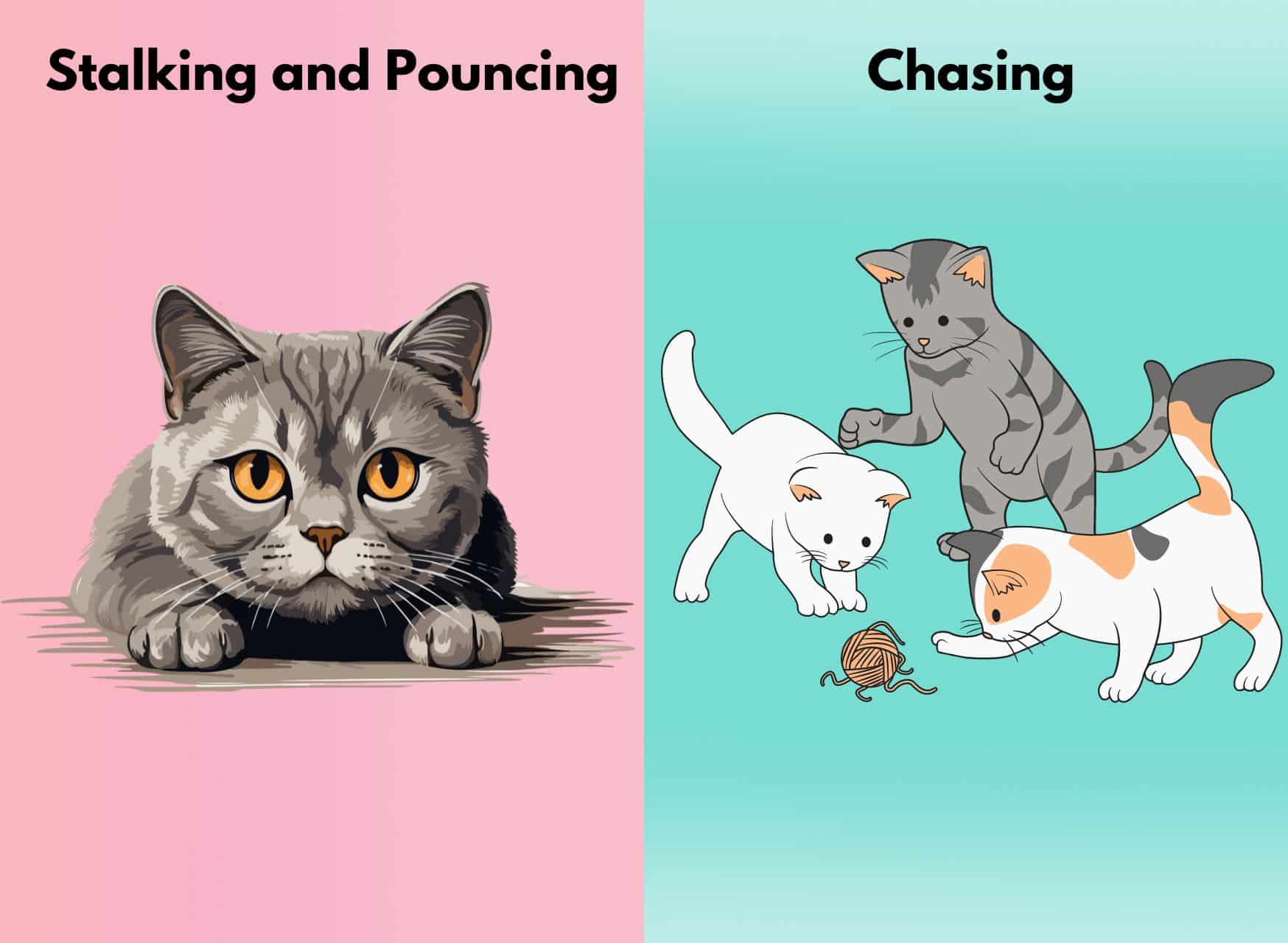
Stalking and Pouncing
Have you ever wondered why your cat transforms into a stealthy hunter, even when chasing a simple feather toy? These behaviors harken back to the wild ancestry ingrained in the behaviors of cats – the very instincts that drove their ancient relatives to stalk and pounce for survival. As your modern-day feline friend hides behind furniture and leaps into the air, they’re not merely indulging in amusement – they’re actively honing their hunting skills, ensuring their instincts remain razor-sharp even within the confines of a domestic setting. It’s a captivating glimpse into their primal past, a story that unfolds with every agile pounce and graceful bounce.
Chasing
Interactive toys and laser pointers aren’t just entertaining distractions – they’re portals to your cat’s inner predator and are behaviors of cats. When they chase that elusive red dot or pounce on a feather teaser, they’re acting out their ancestral drive to chase and catch prey. This playful behavior not only satiates their predatory instincts but also provides a myriad of benefits for their well-being. From improving agility and coordination to combating boredom and stress, interactive play is a cornerstone of your cat’s physical and mental health. So, the next time your cat chases that feather or dashes after a toy mouse, remember, it’s more than just a game – it’s a window into their captivating world of instinctual behaviors.
Grooming and Personal Care
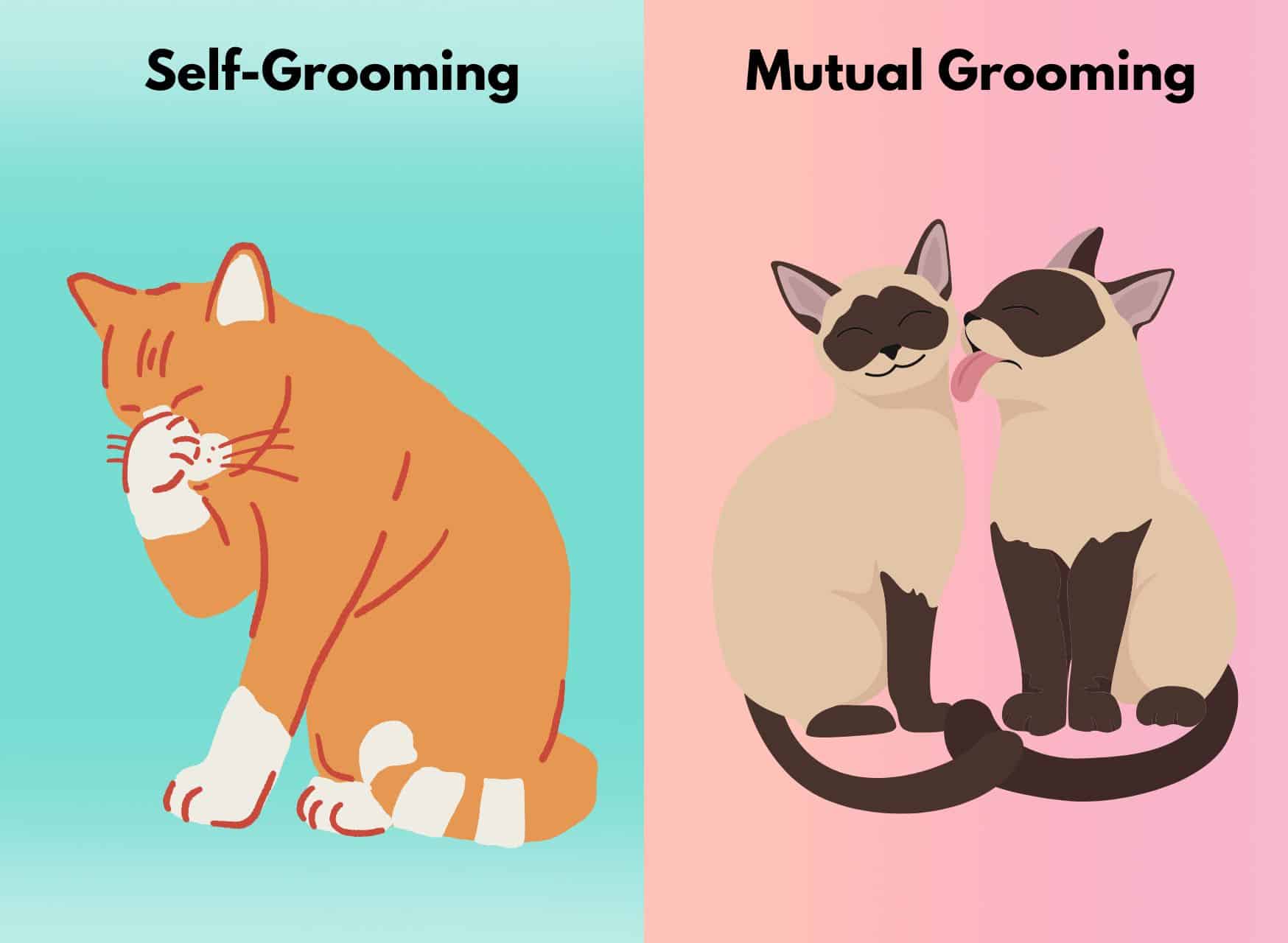
Self-Grooming
The meticulous grooming habits of cats are far more than just vanity – they are a fundamental aspect of their behavior with a variety of purposes. From meticulously licking their fur to maintain cleanliness and regulate body temperature, to spreading their unique scent, these are essential things to know about cat’s behavior. Cats engage in self-grooming as a means of survival and adaptation. However, self-grooming goes beyond just physical upkeep; it’s also a form of self-comfort, akin to a human’s self-soothing behaviors. Moreover, this routine has a social dimension, as a cat grooming themselves can communicate to other cats that they’re content and at ease.
Mutual Grooming
Observing two cats engaged in mutual grooming is like witnessing a private ceremony of trust and companionship. This behavior, known as allogrooming, serves multiple purposes within a group of cats. By grooming each other, cats not only help clean hard-to-reach spots but also reinforce social bonds, creating a sense of community and belonging. This ritualistic cat’s behavior can be particularly prominent in multi-cat households, where it contributes to maintaining harmony and reducing potential conflicts. The act of one cat grooming another is an expression of camaraderie, establishing a foundation of trust that is crucial in the feline world.
Territorial Behaviors
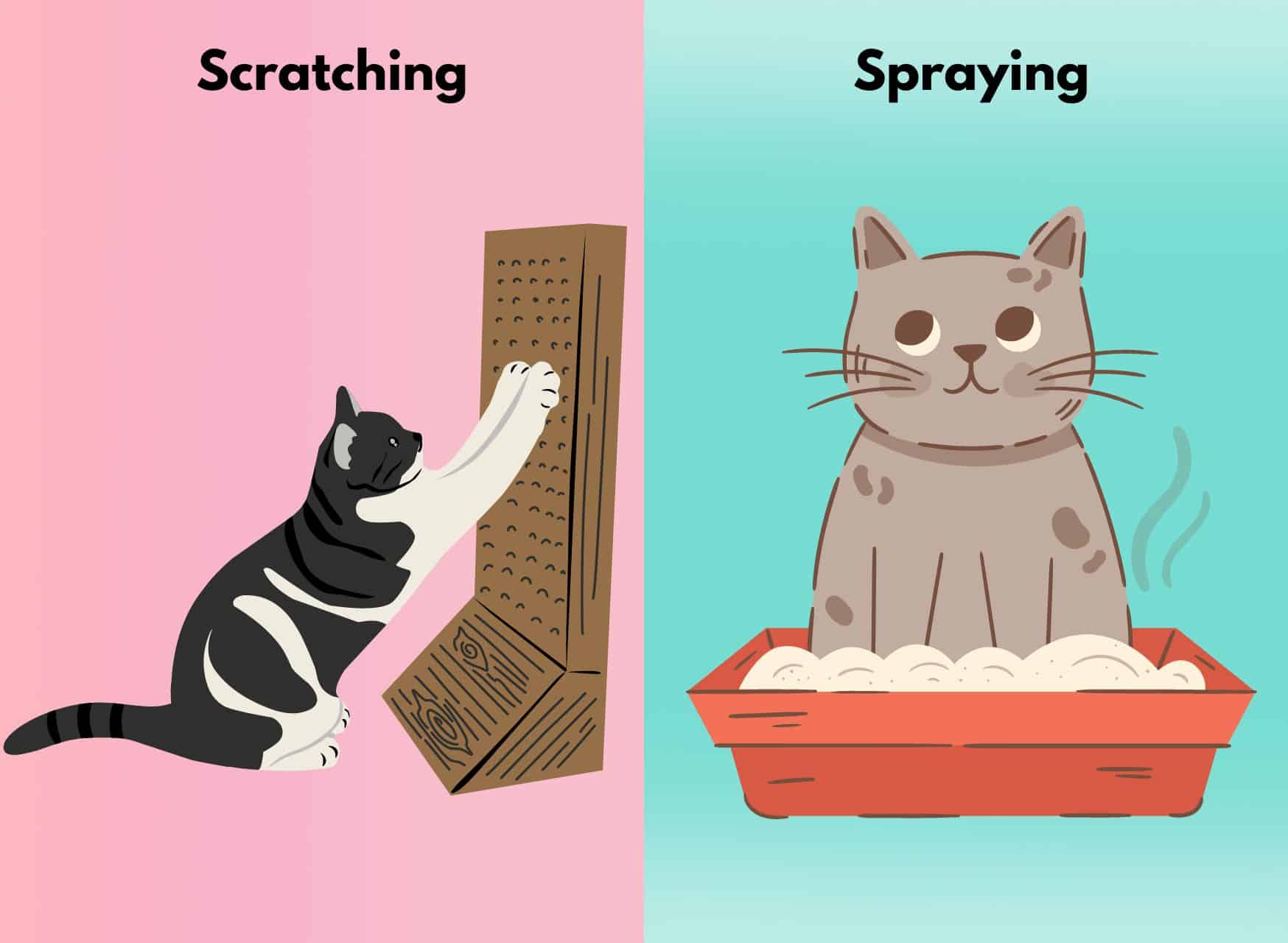
Scratching
Have you ever wondered why your beloved feline insists on turning your furniture into a scratching canvas? It’s not an act of rebellion, but rather an instinctual behavior tied to their territorial nature. Cats scratch to mark their territory visually and through scent glands located in their paws. It’s a way of saying, “This space is mine.” Instead of trying to curb this natural behavior, provide your furry friend with a dedicated scratching post. These posts not only save your furniture but also give them a sense of ownership over their environment – a win-win situation for both you and your territorial companion, especially if you share your space with multiple cats.
Spraying
The distinctive odor of cat urine can carry a cat behavior meaning that goes beyond just the need for a litter box. Spraying, where a cat releases a small amount of urine to mark their territory, is a behavior deeply rooted in their instincts. Whether it’s triggered by the presence of other cats or a change in their environment, spraying is a communication method that conveys a message to other cats.
If you share your home with multiple cats, consider providing ample vertical space, separate feeding stations, and even pheromone diffusers to help alleviate the stress that can lead to spraying. By understanding and addressing this territorial behavior and its cat behavior meaning, you can create a more harmonious living arrangement for both you and your feline companions.
Social behavior
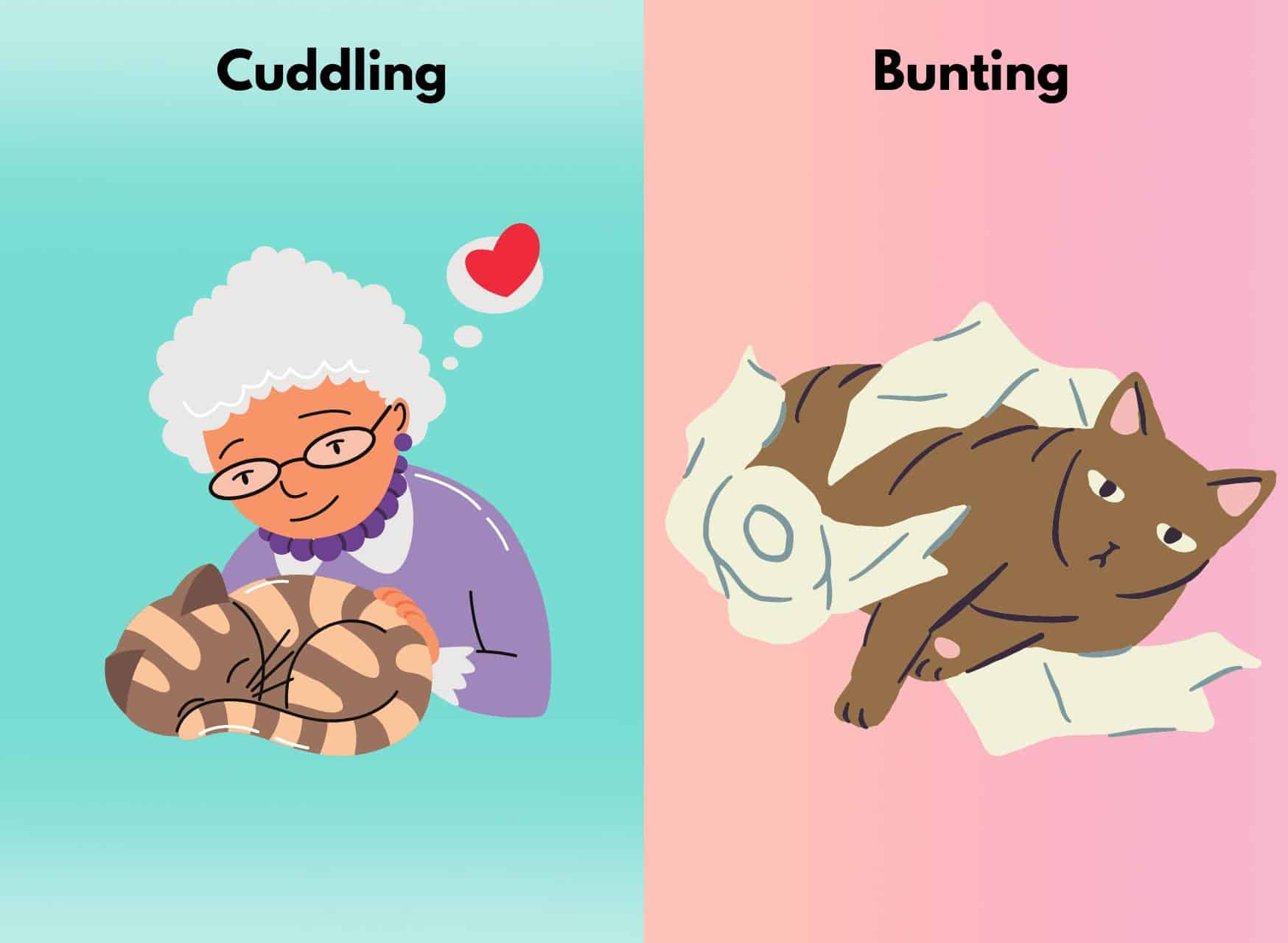
Cuddling
Few things are as heartwarming as a contented cat snuggled up beside you. Cats have their own way of showing affection through close contact, whether it’s curling up on your lap or nestling against your shoulder. Their preferred cuddling style can vary – some cats are “lap warmers,” while others might prefer to be near you without direct physical contact. Recognizing and respecting these cuddling preferences is key to strengthening your bond. As social creatures, cats use these moments of close connection to share warmth and security, a testament to the intricate and heartwarming world of cat behaviors and what they mean, speaking volumes of cat love for you.
Bunting
When your cat rubs their head against you or an object, it’s more than just an affectionate nudge – it’s a display of genuine fondness. This behavior, known as bunting, is a friendly gesture that’s laden with meaning and is a part of their cat’s body language. Not only does it mark you with their scent, claiming you as a part of their territory, but it’s also an act of intimacy and trust. The gentle exchange of scents through bunting creates a unique language that says, “You’re part of my circle, and I feel safe with you.”
So, the next time your cat bunts against your leg or even a piece of furniture, remember, it’s their way of showing their love and loyalty, a silent conversation in the intricate vocabulary of the cat’s behavior.
Litter Box Behaviors
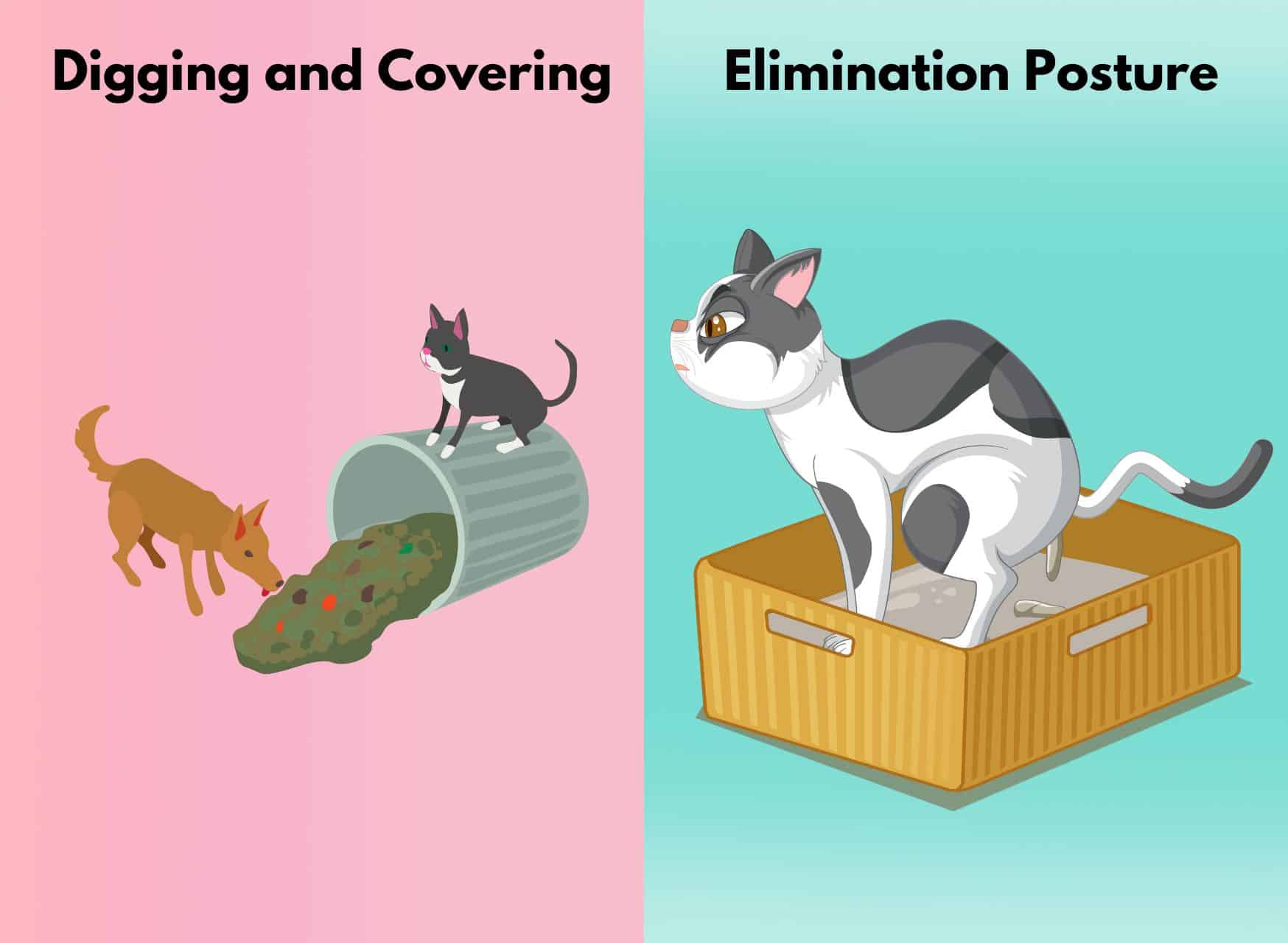
Digging and Covering
The seemingly exaggerated digging and burying routine your cat performs in the litter boxes isn’t just for show – it’s a deeply ingrained behavior with practical purposes. This action is a throwback to their wild instincts when covering waste helped them avoid detection by potential predators. Understanding and respecting this behavior is crucial in maintaining a cat’s sense of security and cleanliness, while also addressing potential cat behavioral issues. However, sudden behavior changes in litter box habits could signal underlying issues, such as stress or medical problems. By addressing litter box concerns promptly and providing a clean, private space, you can ensure your feline friend’s bathroom habits remain consistent and comfortable, mitigating any potential cat behavioral problems.
Elimination Posture
Cats may seem nonchalant about their bathroom routine, but their elimination posture carries significant meaning. Whether they’re standing, squatting, or assuming an unusual position, these postures communicate various emotions and states of well-being, shedding light on potential cat behavioral issues. Observing changes in posture, frequency, or litter box aversion can be indicators of potential urinary problems or discomfort. As vigilant cat lovers, it’s essential to pay attention to these cues and consult a veterinarian if you notice any irregularities. By decoding their elimination behaviors, you can help ensure your cat’s health and happiness, and maintain a harmonious relationship between your cat and their litter box.
Feeding Behaviors

Kneading
The rhythmic motion of your cat kneading on your lap might seem peculiar, but it’s a behavior rooted in their earliest days. Kneading, often accompanied by purring, harks back to kittenhood when they kneaded their mother’s belly to stimulate milk flow. This instinctual cat behavior brings a sense of comfort and security, a nostalgic reminder of their nurturing past. So, when your cat rhythmically presses their paws into your lap or a soft blanket, know that it’s a heartwarming display of affection and a connection to their kittenhood roots that most domestic cats continue to carry with them.
Begging and Pawing
It’s a familiar sight – your cat casting those irresistible, imploring eyes your way during mealtime. While it might be tempting to give in to their adorable begging behaviors, understanding cat behaviors and their origins can help you manage them more effectively. Cats don’t beg simply for the sake of it; it’s a behavior that stems from a combination of curiosity and learned association. Some cats may have learned that certain behaviors result in getting food, leading them to employ tactics like pawing at your leg or staring intently.
To manage feeding-related behaviors, establish a consistent feeding routine, use puzzle toys to engage their minds, and ensure that treats are given in moderation. This way, you can enjoy mealtime with your feline companion while fostering a healthier approach to feeding behaviors.
Aggression and Conflict Behaviors
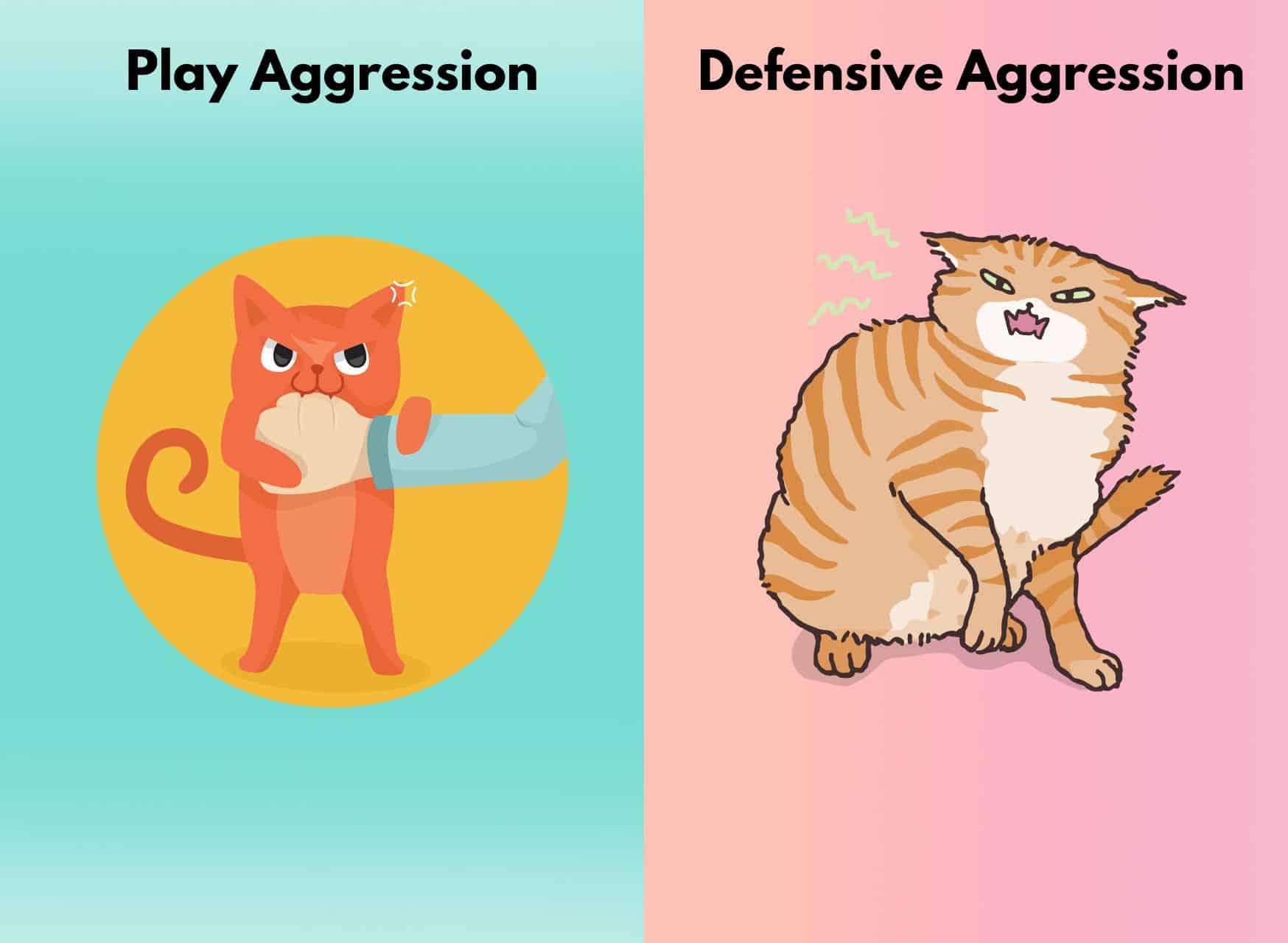
Play Aggression
Ever experienced the sudden switch from affectionate cuddles to what seems like an aggressive attack during play? Play aggression, though it might startle you, is a common cat behavior and is often misunderstood. It’s crucial to differentiate between true aggression and playfulness. Playful biting and scratching are your cat’s way of emulating hunting behavior, a throwback to their wild instincts. Redirecting this energy towards appropriate outlets, such as interactive toys, not only prevents unintentional harm but also ensures your cat gets the stimulation they need. Remember, their intent is not malicious – it’s just another quirky aspect of how cats behave.
Defensive Aggression
A fearful cat can show aggression as a defense mechanism, often leading to confusion and misinterpretation. Identifying the signs of fear-based aggression is key to understanding cat behaviors. If your feline friend hisses, growls, or even swats when cornered or feeling threatened, it’s likely a response to their fear. To help a fearful cat feel secure, provide safe spaces where they can retreat, and avoid forcing interactions. Patience and gradual exposure to new experiences can gradually reduce their fear-based reactions. Remember, weird cat behavior often stems from underlying emotions, and by addressing their fears, you can foster a more harmonious relationship and a calmer environment for both of you.
Curiosity and Investigative Behaviors

Poking and Pawing
Cats are the ultimate explorers, and their paws are their primary tools for investigating the world around them. Whether they’re poking at an object or swatting at something hanging in the air, these actions are more than just playful whims – they’re their way of understanding their environment. Encouraging investigative behaviors enriches their lives and prevents potential cat behavioral issues. Provide them with a variety of textures, shapes, and objects to explore, and consider puzzle toys that stimulate their minds. By embracing their curiosity, you’re fostering a fulfilling and engaging environment that resonates with their natural instinct.
Exploring Small Spaces
From cardboard boxes to the hidden corners of a room, cats possess an innate fascination with confined spaces. These cozy retreats offer security and the thrill of exploration, much like a mini-adventure. As responsible cat owners, it’s essential to provide safe opportunities for them to indulge this curiosity. Ensure that small spaces are free of hazards, and occasionally rotate and refresh their options to keep things interesting. By understanding and accommodating their desire for exploration, you’re not only preventing potential behavioral issues but also enhancing your cat’s quality of life through a world that’s both stimulating and secure, alleviating concerns about cat behaviors to worry about.
Nighttime Behaviors
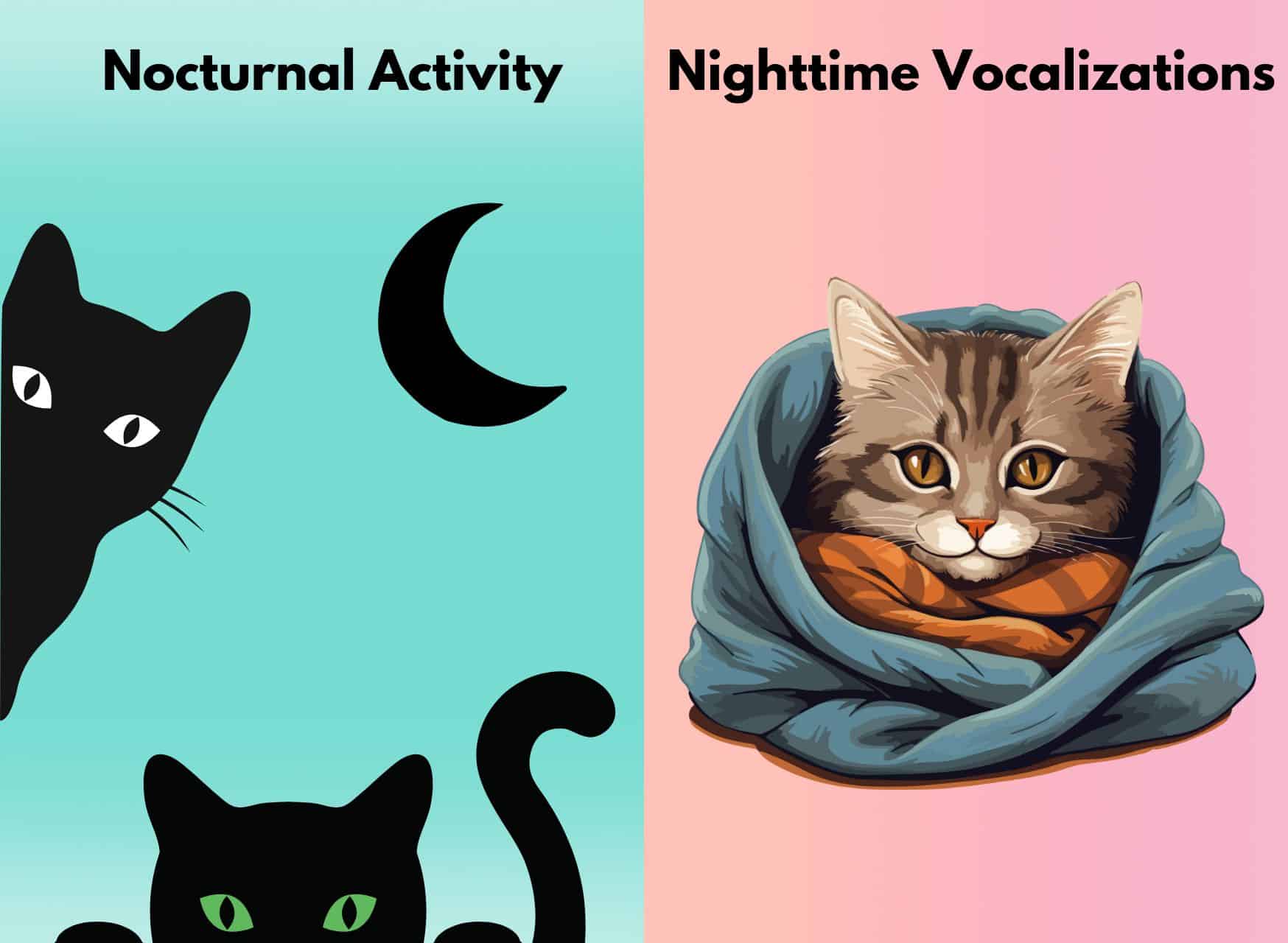
Nocturnal Activity
Cats seem to have an uncanny ability to transform into nocturnal explorers once the sun sets. Understanding the reasons behind their nighttime antics sheds light on their natural behavior. Cats are crepuscular creatures, meaning they’re most active during dawn and dusk. This behavior is a throwback to their wild ancestors, who were more active during these times to hunt and avoid predators. While it might challenge your good night’s sleep, consider providing engaging activities during the evening, such as interactive play and puzzle feeders. Investing in a comfortable cat bed close to your sleeping area can also ease their nighttime restlessness.
Nighttime Vocalizations
If you’ve ever been woken up by your cat’s vocal serenades in the middle of the night, you’re not alone. Excessive meowing or yowling at night can be frustrating, but it’s essential to address the underlying causes. Cats may vocalize due to loneliness, illness, or even their natural instincts. If your feline friend’s nighttime vocalizations are becoming a concern, it’s recommended to consult a veterinarian to rule out any health issues. Creating a calming bedtime routine and providing stimulating activities during the day can help reduce nighttime restlessness. By understanding these aspects of a cat’s behavior, you can harmonize their natural rhythms with your own, ensuring both you and your cat get the peaceful rest you deserve.
Tips for promoting positive common cat behaviors
Promoting positive cat behavior is essential for a harmonious and fulfilling relationship with your feline friend. Here are some tips to enhance their well-being
1. Provide environmental enrichment: Cats need mental and physical stimulation to thrive. Offer scratching posts, climbing trees, puzzle toys, and hiding spots to keep them engaged and entertained.
2. Engage in interactive play: Regular play sessions with interactive toys can provide exercise and mental stimulation. Find toys that mimic prey movements to tap into their natural hunting instincts.
3. Create a safe space: Cats need a designated area where they can retreat and feel safe. Provide cozy beds, blankets, or cat trees where they can relax and observe their surroundings.
4. Establish a routine: Cats thrive on routine and predictability. Ensure you have consistent feeding times, play sessions, and quiet time to create a sense of security and stability.
5. Positive reinforcement: Reward desired behaviors with treats, praise, or playtime. Cats respond well to positive reinforcement, so reinforce good behavior whenever possible.
By implementing these tips, you can create a stimulating and nurturing environment that promotes positive behavior and strengthens your bond with your cat.
Conclusion
In the captivating tapestry of feline life, we’ve explored the rich spectrum of common cat behaviors that make these enigmatic creatures truly special. As cat owners, the path to a stronger bond with our furry companions lies in keen observation and genuine appreciation. Each whisker twitch, playful chase, and contented purr speaks volumes of their unique personalities. Remember, patience is key when navigating the intricacies of cat behavior.
So, the next time your cat bunts your hand, chases a toy with sheer abandon, or curls up beside you in contentment, take a moment to cherish the depth of the connection you share. By embracing their behaviors with understanding and positive reinforcement, you’re not only nurturing their well-being but also creating a tapestry of moments that celebrate the beauty and complexity of our beloved feline companions. Through this journey of discovery, we find ourselves not just pet owners, but privileged witnesses to the fascinating world of popular cat behaviors – a world that enriches our lives in ways only a cat can.
Sharing is Caring!
About The Author
PawCool Team
Related Categories: Cats | Cat Stories
Latest Articles

Never Miss A Thing!
All pet stories & guides you care about




